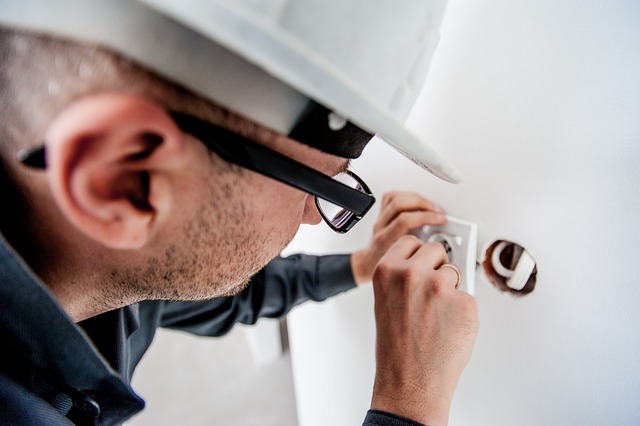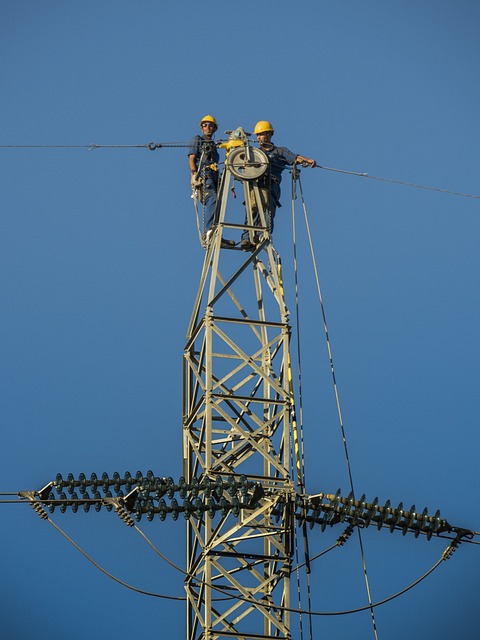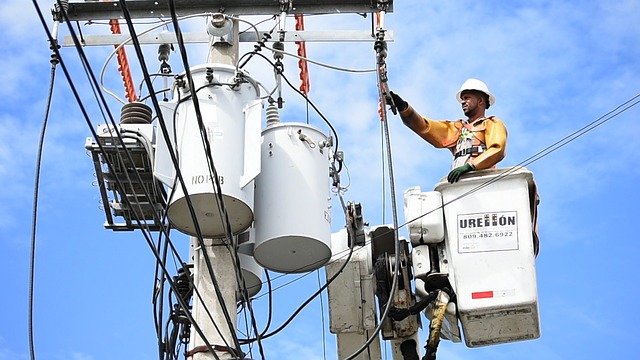Essential Guide to Installing Backup Generators with Professional Electricians for Robust Business Continuity
Backup power systems are essential for modern infrastructure, providing uninterrupted power during outages and safeguarding both residential and commercial sectors. Electricians are key professionals in deploying these systems, including automated generators that switch on during power failures. The…….

Backup power systems are essential for modern infrastructure, providing uninterrupted power during outages and safeguarding both residential and commercial sectors. Electricians are key professionals in deploying these systems, including automated generators that switch on during power failures. These systems ensure the continuity of vital services and protect sensitive equipment from voltage irregularities. The expertise of electricians is critical for a smooth transition to backup power sources, minimizing disruption and potential disaster risks. The integration of these systems is crucial for preparedness, reliability, and safety in contemporary infrastructure planning.
Electricians are vital in assessing energy needs, selecting the appropriate backup generator size and fuel type, and ensuring compliance with local codes during installation. They install transfer switches that automatically connect to backup power sources and ensure proper grounding, ventilation for gas-powered units, and connection to a fuel source for safety and reliability.
For businesses, an electrician's role is to tailor backup solutions like generators and UPS to meet specific needs, ensuring operational continuity and protecting against data loss, equipment damage, and cybersecurity threats during outages. Regular maintenance by skilled electricians ensures that these systems remain dependable, reinforcing customer confidence and resilience.
In summary, electricians are integral to the reliable integration of backup power systems, which are vital for maintaining business continuity and ensuring safety and security during unexpected power disruptions. Their expertise in system design, installation, testing, and maintenance is essential for safeguarding against the risks associated with prolonged power loss incidents.
When the power grid falters, the stakes are high for businesses and critical infrastructure. This article delves into the integral role of backup power systems, emphasizing their significance in maintaining operations during outages. We explore key considerations for selecting a generator, the collaborative process with electricians in installation, and the various types of generators available. From a comprehensive guide on integrating backup generators in commercial settings to essential safety precautions, our discussion encompasses maintenance, cost analysis, real-world applications across industries, environmental considerations, and future trends in power solutions. Partnering with electricians is pivotal for upgrading existing systems and ensuring staff are trained for safe operation and maintenance. Join us as we navigate the complexities of safeguarding against power disruptions with reliable backup systems.
- Understanding the Role of Backup Power Systems in Modern Infrastructure
- The Importance of Reliable Backup Power for Business Continuity
- Key Considerations When Selecting a Generator for Backup Power Needs
- An Overview of Installing Backup Generators: A Collaborative Effort with Electricians
- Step-by-Step Guide to Installing a Backup Generator in Commercial Settings
Understanding the Role of Backup Power Systems in Modern Infrastructure

backup power systems have become a cornerstone of modern infrastructure, providing essential resilience to both commercial and residential operations. In an era where electricity is the lifeblood of daily activities, from running hospitals to maintaining data centers, the sudden loss of power can lead to costly downtime and potential safety hazards. Electricians play a pivotal role in designing and installing these backup systems, which often include generators that automatically engage when utility-supplied power fails. These systems are critical for maintaining uninterrupted power during outages caused by natural disasters, grid failures, or other emergencies. Their function is to ensure continuity of operations and protect sensitive equipment from voltage fluctuations or surges that can occur when power is unexpectedly restored. As a result, the role of electricians in implementing these systems cannot be overstated; their expertise guarantees that when the primary power source falters, backup generators kick in seamlessly, minimizing disruption and safeguarding against potential catastrophes. The integration of backup power systems is not just about preparedness for unexpected events but also about maintaining the reliability and safety of our increasingly interconnected world. It underscores the importance of considering robust energy solutions as a standard component in modern infrastructure planning and development.
The Importance of Reliable Backup Power for Business Continuity

In today’s fast-paced business environment, the uninterrupted flow of operations is paramount for success. A critical component of maintaining this continuity is the implementation of reliable backup power systems. When primary power sources fail due to natural disasters, human error, or utility grid issues, a robust backup power system can ensure that business activities proceed without significant downtime. Electricians play a pivotal role in installing and maintaining these systems, which often include generators and uninterruptible power supplies (UPS). The seamless transition from main to backup power is not just about safeguarding against data loss or equipment damage; it’s about protecting the financial well-being and reputation of the business. For instance, a data center equipped with a reliable backup power system can continue to operate, securing sensitive client information and preventing potential breaches that could occur in a power outage. The expertise of electricians is indispensable in designing and executing these systems to meet the unique demands of different businesses, from small offices to large-scale industrial facilities. Their work ensures that when the lights flicker or go out, business operations can carry on, minimizing disruption and maintaining customer trust and satisfaction.
Key Considerations When Selecting a Generator for Backup Power Needs

When selecting a generator for backup power systems, it’s crucial to consider the specific electrical needs of your home or business. An experienced electrician plays a pivotal role in this process, as they can assess your energy requirements and recommend a generator model that aligns with your usage patterns and emergency power priorities. The size and capacity of the generator must match the critical loads you intend to power during an outage. Factors such as the total wattage of essential devices, the frequency of power disruptions in your area, and the type of equipment you wish to run should all inform your decision. Additionally, the fuel type of the generator—whether it’s gasoline, propane, or diesel—can affect its reliability, maintenance needs, and overall cost of operation. An electrician can also guide you on the installation process, ensuring that the generator is properly sized, placed, and connected to provide seamless backup power during unexpected power losses. It’s imperative to choose a qualified professional who understands local codes and regulations to ensure your backup power system is safe, effective, and compliant with all necessary standards. With careful selection and expert installation by a competent electrician, your backup generator will be a dependable source of power, safeguarding your home or business against the inconvenience and potential risks associated with prolonged power outages.
An Overview of Installing Backup Generators: A Collaborative Effort with Electricians

Backup power systems are increasingly becoming a critical component in both residential and commercial settings to ensure uninterrupted operations and safety during power outages. Installing backup generators, a task that requires specialized knowledge and expertise, is a collaborative effort involving skilled electricians. These professionals play a pivotal role in the process, from assessing the power needs of a facility to the technical installation of the generator equipment. The integration of a backup generator involves meticulous planning and adherence to local building codes and safety standards. Electricians work closely with homeowners or facility managers to determine the appropriate size and type of generator required to meet the specific energy demands, ensuring that the system will function seamlessly during an outage.
The installation process begins with a thorough evaluation of the existing electrical system to ensure compatibility and optimal performance. Electricians then proceed with the setup of the transfer switch, which is the component that connects the generator to the home or building’s electrical circuitry. This critical step ensures that power will automatically switch from the main supply to the generator without any manual intervention, providing a smooth transition and uninterrupted service. Throughout the installation, electricians also ensure that the backup generator is correctly grounded, properly ventilated if it’s a gas-powered unit, and connected to an adequate fuel source, such as a propane tank or natural gas line. This collaborative effort between homeowners, facility managers, and licensed electricians not only enhances the reliability of power supply but also offers peace of mind in the event of unexpected power disruptions.
Step-by-Step Guide to Installing a Backup Generator in Commercial Settings

When commercial entities prioritize resilience and uninterrupted operations, installing a backup generator becomes an indispensable measure. A seasoned electrician plays a pivotal role in this process, ensuring that the power supply remains consistent even during outages. The installation of a backup generator is a multifaceted project that requires careful planning and execution.
The first step involves selecting the appropriate generator size and type for the commercial setting’s specific energy needs. An electrician will assess the facility’s power consumption, critical operations, and potential load requirements to recommend a suitable generator. Once the generator is chosen, the installation process begins with securing necessary permits and ensuring compliance with local regulations. The electrician will then proceed to install the generator at an optimal location, considering factors like accessibility for maintenance and proximity to fuel sources if needed.
Next, the electrician will set up transfer switches that automatically switch from the main power supply to the generator in the event of a utility outage. This critical component must be properly synchronized with both power sources to prevent electrical surges or backfeeding into the utility grid, which could cause damage or harm utility workers responding to an outage.
The electrician will then connect the generator to the facility’s critical power systems, ensuring that essential operations such as IT infrastructure, lighting, and security systems remain operational. After verifying the connections, the system is loaded-tested under the electrician’s supervision to ensure it operates correctly during a simulated power outage.
Finally, the electrician will perform regular maintenance checks to guarantee the generator functions optimally and efficiently. This includes routine inspections, battery testing, fuel quality monitoring, and adjustments as necessary. By following these steps meticulously, commercial entities can safeguard their operations against power disruptions with a reliable backup generator system.
When an unexpected power outage strikes, the reliance on backup power systems becomes crystal clear. As detailed in our exploration, these critical assets play a pivotal role in safeguarding modern infrastructure and ensuring business continuity. Selecting the right generator is a strategic decision that requires careful consideration of capacity, efficiency, and compatibility with existing systems. The installation process, as outlined, is a specialized task best handled by skilled electricians who can seamlessly integrate these systems into your operational framework. By following the step-by-step guide for commercial settings, businesses can confidently fortify their operations against power disruptions. In conclusion, investing in backup power solutions, facilitated by expert electricians, is a proactive measure that pays dividends in maintaining uninterrupted service and protecting your enterprise’s vital functions.







